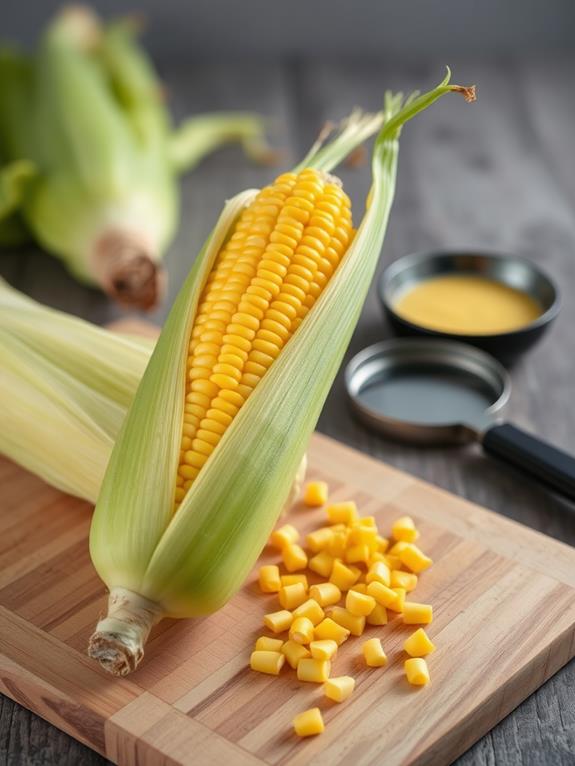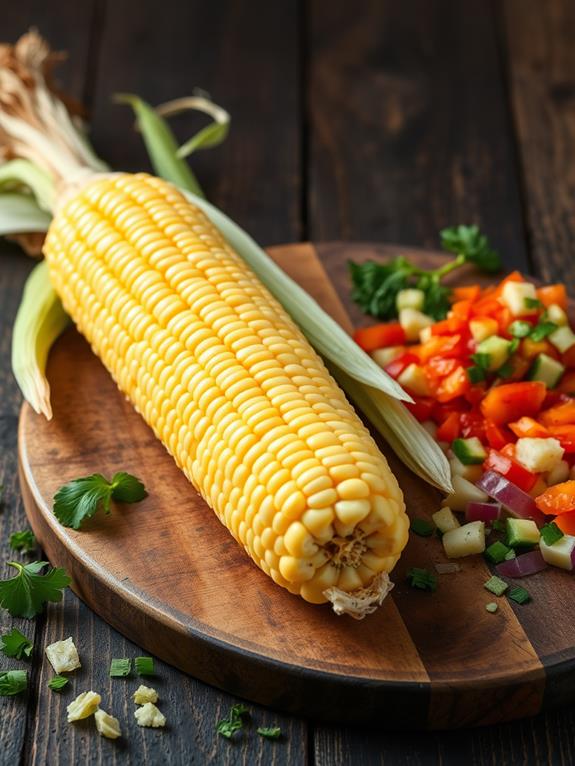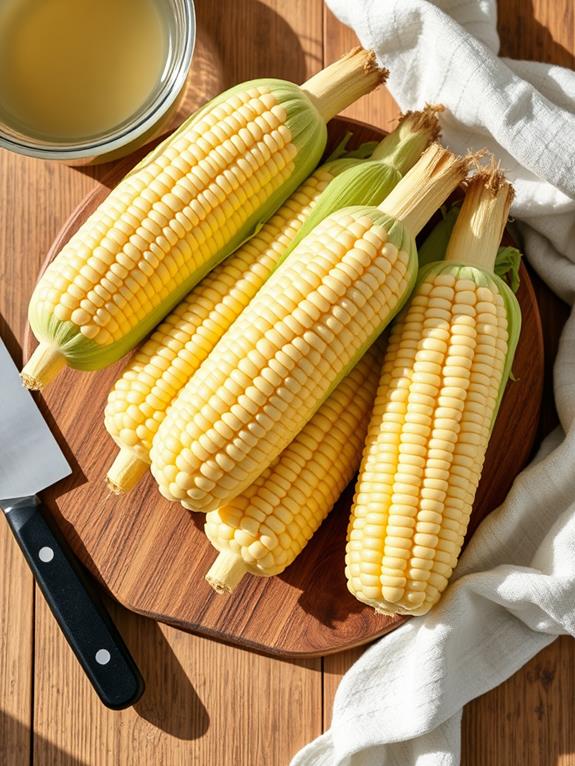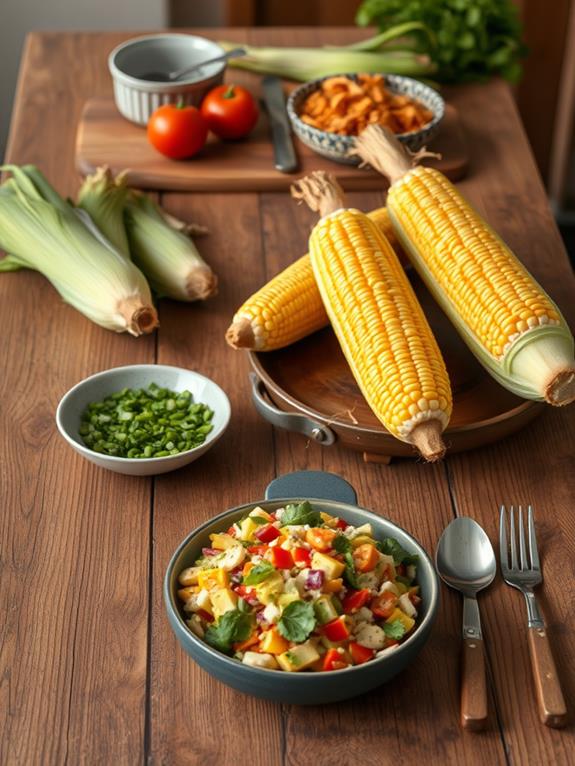Is It Safe to Eat Raw Corn on the Cob
Raw corn on the cob is generally safe to eat and can be a nutritious addition to your diet. It's rich in fiber, vitamins, and minerals, while retaining more nutrients than cooked corn due to lack of heat exposure. However, you should take precautions when consuming raw corn. Thoroughly wash the cob to remove potential contaminants, and select fresh ears with plump kernels and vibrant green husks. Individuals with weakened immune systems or digestive issues should exercise caution. While raw corn is safe for most people, it's important to chew thoroughly to aid digestion and reduce choking risks. Moderation is key to maximize benefits and minimize potential digestive discomfort. Further exploration will reveal various culinary applications and cultural significance of raw corn consumption.
This post may contain affiliate links. If you make a purchase through these links, I may earn a commission at no additional cost to you. Additionally, portions of this post may be generated using artificial intelligence (AI) technology. While we strive for accuracy, please be aware that AI-generated content may not always be perfect and should be fact-checked when necessary.
The Spatula Scoops
- Raw corn on the cob is generally safe to eat, especially sweet corn varieties.
- Thoroughly wash corn under running water to remove dirt and potential contaminants before consumption.
- Select fresh corn with plump, full kernels and vibrant green husks for optimal safety and taste.
- Individuals with weakened immune systems or digestive issues should exercise caution when eating raw corn.
- Consume raw corn shortly after purchase and avoid ears showing signs of spoilage or damage.
Safety Concerns of Raw Corn

How safe is it to munch on raw corn straight from the cob? You'll be glad to know that eating raw corn is generally safe, especially when you choose sweet corn varieties. However, there are a few safety concerns you should keep in mind before indulging in this crunchy treat.
First and foremost, it's essential to wash the corn thoroughly before eating. This step helps remove potential contaminants like dirt or bacteria that may be present on the surface. When selecting corn to eat raw, opt for fresh corn with full kernels extending to the top of the cob, as this indicates ripeness and safety for consumption.
While most people can enjoy raw corn without issues, those with weakened immune systems or digestive problems should exercise caution. If you fall into this category, consider your tolerance for raw foods before consuming raw corn. To minimize risks, it's best to eat raw corn shortly after purchase and avoid any ears showing signs of spoilage or damage. By following these precautions, you can safely enjoy the sweet, crisp texture of raw corn on the cob.
Nutritional Benefits and Drawbacks

The nutritional profile of raw corn offers a compelling mix of benefits and potential drawbacks. When you eat raw sweet corn, you're getting a fiber-rich snack that's lower in calories than many processed alternatives. It's safe to consume and packed with essential vitamins and minerals, including vitamins A, B, C, and E, which support your immune system and overall health. The natural sweetness and crunch of raw corn offer a unique eating experience, characterized by its juicy texture. Additionally, like painted backsplashes, raw corn provides health benefits by retaining higher levels of nutrients compared to cooked varieties, as heat can diminish their potency. You'll also benefit from the complex carbohydrates that provide sustained energy without the nutrient loss associated with cooking.
However, it's important to be aware of potential drawbacks. Overconsumption of raw corn may lead to increased sugar levels in your body. Additionally, its high cellulose content could cause digestive discomfort for some people. While the nutritional value of raw corn is undeniable, moderation is key to reaping its benefits without experiencing negative effects.
Preparing Raw Corn Safely

When it comes to enjoying raw corn safely, proper preparation is key. To eat raw corn with confidence, start by selecting high-quality corn on the cob, similar to how you would choose ingredients for a dish, like using Diamond Crystal Kosher Salt for enhanced flavor. Look for ears with full, plump kernels and vibrant green husks. These characteristics indicate freshness and reduce the risk of spoilage.
Once you've chosen your corn, it's essential to wash the corn thoroughly under running water. This step removes dirt, debris, and potential bacteria, ensuring better safety for raw consumption. After washing, carefully shuck the corn and remove all silk before giving it a final rinse. This process helps prevent contamination during preparation.
For the best sweet taste and nutritional value, consume raw corn shortly after purchasing. The sugars in corn begin converting to starch over time, affecting both flavor and nutritional content. When you're ready to eat, be mindful of thorough chewing, especially if serving to young children. Raw corn's high cellulose content requires careful mastication to aid digestion and minimize choking hazards.
Culinary Uses for Raw Corn

Embracing raw corn in your culinary repertoire opens up a world of fresh, vibrant possibilities. When you're looking to enjoy corn in its natural state, you'll find that raw corn is safe and packed with fiber. It's a versatile ingredient that can elevate your summer salads, adding a sweet crunch to every bite. You might even consider how the colors of your ingredients can enhance the overall presentation, similar to how timeless shades like Hale Navy enrich kitchen aesthetics with their elegance.
You can easily incorporate raw corn into various dishes. Slice it off the cob and toss it into fresh salads for a burst of flavor and texture. If you're in the mood for something zesty, mix it into salsas alongside tomatoes, onions, and cilantro. For a simple yet delicious snack, try eating raw corn directly off the cob, seasoned with lime, salt, and chili.
Looking to get creative? Add raw corn to your smoothies for a unique sweetness, or use it in gourmet appetizers like bruschetta. The natural sweetness of corn complements fruits and light dressings beautifully. By exploring these culinary uses, you'll discover that raw corn is considered a versatile ingredient that can transform your meals with its fresh, crisp texture and natural sweetness.
Cultural Perspectives on Raw Corn

Across diverse cultures worldwide, raw corn holds a special place in culinary traditions and social customs. You'll find that many cultures have embraced raw corn as a safe and delicious ingredient in their traditional dishes. For instance, in Mexico, you can experience the popular street food elote, which often features raw corn kernels as a key component. Additionally, raw corn's nutritional value makes it a favored choice for health-conscious consumers, with many seeking to incorporate it into various recipes. Native American communities have long enjoyed raw ears of corn as a staple food, highlighting its cultural significance.
In warmer climates like Brazil and the Philippines, you'll discover raw corn incorporated into invigorating salads and street foods, perfect for hot summer days. The United States showcases regional variations in raw corn consumption, with Southern states favoring it in salads while Northern areas lean towards cooked preparations.
Cultural events like Indiana's Sweet Corn Festival celebrate raw corn's importance, offering a platform for sharing recipes and traditions. These festivals demonstrate how deeply ingrained raw corn is in various culinary heritages. As you explore different cultures, you'll notice that raw corn's versatility and nutritional value makes it a beloved ingredient in diverse cuisines around the world.
Frequently Asked Questions
Is Uncooked Corn Safe to Eat?
Yes, you can safely eat uncooked corn on the cob. It's sweet, crunchy, and nutritious. However, you'll want to follow a few precautions:
- Choose fresh, sweet corn varieties.
- Wash the corn thoroughly to remove potential contaminants.
- Consume young, tender corn for the best flavor and texture.
- Be aware of possible allergies or choking hazards for children.
Can You Eat Corn on the Cob Without Boiling It?
Yes, you can eat corn on the cob without boiling it. Raw sweet corn is safe and nutritious when properly cleaned. For the best flavor and texture, choose fresh cobs with plump kernels that reach the top. Raw corn offers a crunchy, sweet taste with a milkier flavor compared to cooked corn. Remember to wash it thoroughly to remove potential contaminants. Eating corn raw can preserve more nutrients, including vitamins B and C, as well as antioxidants, than its cooked counterpart.
How Can You Tell if Corn on the Cob Is Safe to Eat?
"Is your corn safe to eat?" you might wonder. To tell, start by selecting ears that feel dense and heavy, with plump kernels reaching the husk's top. Check for bright green, tightly wrapped husks, avoiding dried or browning ones. Wash the corn thoroughly under running water to remove dirt and potential bacteria. Inspect kernels for mold or dark spots. Remember, freshness is key – consume promptly after purchase for the best quality and safety.
Does Corn on the Cob Need to Be Cooked?
You don't necessarily need to cook corn on the cob. While cooking can enhance flavor and digestibility, it's perfectly safe to eat raw, especially sweet corn varieties. Raw corn retains more nutrients and offers a crisp texture. However, if you prefer a softer consistency or want to bring out different flavors, cooking is an option. Whether you choose to eat it raw or cooked, always wash the corn thoroughly to remove potential contaminants. The choice ultimately depends on your personal taste preference.





